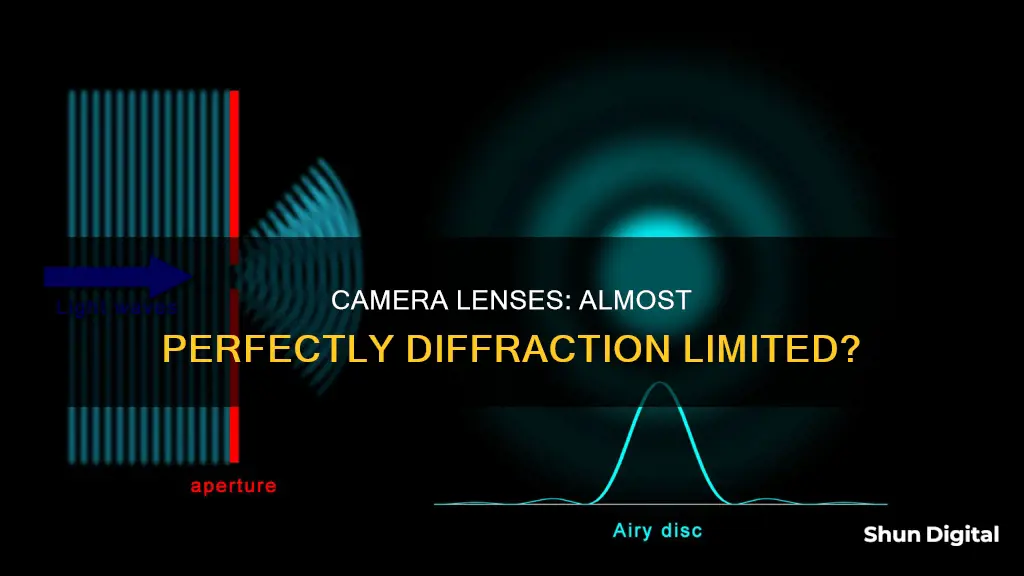
Diffraction is an optical effect that limits the resolution of a photograph. It occurs when light passes through a small opening, such as a camera aperture, and begins to disperse or diffract. This effect becomes more significant as the aperture size decreases, causing light rays to interfere with one another and resulting in a loss of sharpness in the image. While diffraction is a natural characteristic of all lenses, it is possible to minimise its impact by using larger apertures. The extent to which camera lenses are diffraction-limited depends on various factors, including the camera type, lens quality, and the subject being photographed.
| Characteristics | Values |
|---|---|
| What is diffraction | A physical characteristic of all lenses and an optical effect that limits the resolution of a photograph |
| What causes diffraction | The presence of the aperture edge |
| What does diffraction cause | A photograph to grow progressively less sharp at small aperture values |
| What are the effects of diffraction | The sharpness of a photograph decreases at smaller and smaller apertures |
| What is the theoretical maximum resolution | Limited by the f-number of the lens and the wavelength of light being imaged |
| What is the Airy disk | The appearance of a diffraction pattern when it hits a camera sensor |
| What is the Modulation Transfer Function (MTF) | The percent contrast vs. resolution curve |
| What is the Diffraction-Limited Aperture (DLA) | The aperture value where diffraction begins to visibly negatively affect image sharpness at the pixel level |
What You'll Learn

Diffraction is an optical effect that limits resolution
Diffraction is an optical effect that limits the resolution of a photograph. It occurs because light passing through a small opening (like a camera aperture) begins to disperse or "diffract". This effect is usually negligible, as smaller apertures tend to improve sharpness by reducing lens aberrations. However, for very small apertures, this strategy becomes counterproductive, and the camera is said to be diffraction-limited.
Diffraction occurs because light rays passing through a small aperture diverge and interfere with one another. This effect becomes more significant as the aperture size decreases relative to the wavelength of light passing through. As the divergent rays travel different distances, some move out of phase and begin to interfere with each other, adding together in some places and cancelling out in others. This interference produces a diffraction pattern with peak intensities where the amplitude of the light waves adds together, and less light where they cancel each other out.
The 2-D diffraction pattern created by an ideal circular aperture is known as an "airy disk", named after its discoverer George Airy. The width of the airy disk defines the maximum theoretical resolution for an optical system. When the diameter of the airy disk's central peak becomes large relative to the pixel size in the camera, it starts to impact the image visually. Once two airy disks are closer together than half their width, they are no longer individually resolvable (according to the Rayleigh criterion).
Diffraction sets a fundamental resolution limit that is independent of the number of megapixels or film format. It depends only on the f-number of the lens and the wavelength of light being imaged. It can be thought of as the smallest theoretical "pixel" of detail in photography.
Diffraction is a physical characteristic of all lenses and will limit the resolution that can be achieved from a camera and lens. Each camera and lens combination will have a diffraction limit or range, and once you go beyond this in terms of aperture size, your images will become less sharp. Diffraction is a function of sensor size and aperture (or f-stop). As you reduce the aperture size, the light waves deform as they pass through the aperture diaphragm blades, spreading out in a fan-like shape. This "fanning" has serious consequences for the sharpness of the image.
Diffraction is not unique to photography; it can occur with any kind of wave, including sound waves and water waves. Diffraction sets a fundamental limit to the resolution of not just cameras, but also telescopes and microscopes.
Understanding APS-C Camera and Lens Cropping: What's the Difference?
You may want to see also

Diffraction occurs when light passes through a small opening
Diffraction is an optical effect that occurs when light passes through a small opening, such as a camera aperture. It is a physical characteristic of all lenses and causes light rays to disperse or "diffract", reducing the total resolution of the photograph. Diffraction is caused by the presence of the aperture edge, with light bending around this edge and interfering with one another. This interference results in a diffraction pattern with peak intensities where the amplitude of the light waves adds up and less light where they cancel each other out.
The amount of diffraction depends on the size of the aperture relative to the wavelength of light passing through. Smaller apertures result in greater diffraction, with light waves spreading out and interfering more. This leads to a loss of sharpness in the photograph as the light no longer travels in a straight line, reducing the definition of edges and causing lines to blur together.
The impact of diffraction on image quality can be observed by examining the Airy disk, which is the appearance of a diffraction pattern when it hits the camera sensor. The Airy disk becomes larger as the aperture size decreases, resulting in a blurrier image.
Different camera types exhibit diffraction effects at different aperture sizes. Full-frame cameras typically start to show diffraction effects between f/8 and f/11, while smaller sensors such as those found in point-and-shoot cameras or mobile phones exhibit diffraction at lower f-stops such as f/4 and f/5.6. Medium and large format cameras, on the other hand, can handle much smaller apertures before diffraction becomes visible.
While diffraction is a natural consequence of the physics of light and lenses, photographers can take steps to minimise its impact on their images. Using larger apertures is one way to avoid diffraction, as light waves pass through with minimal interference. Additionally, post-processing techniques such as sharpening can improve the apparent detail of photographs taken at small apertures, although this does not eliminate the underlying diffraction effects.
Choosing a Camera: Body, Lens, and Compatibility
You may want to see also

Diffraction impacts sharpness
Diffraction is an optical effect that limits the total resolution of a photograph, regardless of the number of megapixels in the camera. It occurs because light begins to disperse when passing through a small opening, such as a camera's aperture. While smaller apertures can improve sharpness by minimising lens aberrations, for very small apertures, this strategy becomes counterproductive, and the camera becomes diffraction-limited.
The impact of diffraction on sharpness depends on the size of the camera sensor. Smaller sensors, such as those found in cropped-frame or full-frame DSLR cameras, will start to show diffraction effects at higher f-stop values (around f/8 to f/11) compared to larger sensors. Medium and large format cameras can handle much smaller apertures before diffraction effects become visible.
Diffraction also depends on the wavelength of light. Shorter wavelengths of light, such as blue light, will diffract more readily than longer wavelengths, such as red light. However, in practice, this has a minimal impact on photographs.
To avoid the effects of diffraction, photographers can use a larger aperture, as diffraction is not an issue at large apertures like f/4. Additionally, focus stacking at apertures where diffraction is minimal (such as f/5.6 or f/8) can help achieve a large depth of field while maintaining sharpness.
Q-See Camera Lenses: Plastic or Glass?
You may want to see also

Diffraction is caused by light waves interfering with one another
Diffraction is a phenomenon that occurs when waves, including light waves, encounter an obstacle and bend around it. In the case of light, diffraction happens when it passes through a small opening, such as a camera's aperture, causing the light waves to spread out and interfere with one another. This interference results in a loss of sharpness in photographs as the aperture size decreases.
When light passes through a narrow aperture, it begins to diverge and interfere with itself. This effect becomes more noticeable as the aperture size decreases in relation to the wavelength of light passing through. The divergent rays now travel different distances, causing them to move out of phase and interfere with each other. This interference creates a pattern of varying intensity, known as a diffraction pattern, with areas of constructive and destructive interference.
In the context of photography, the diffraction pattern is known as an "airy disk," named after its discoverer, George Airy. The width of the airy disk defines the maximum resolution achievable by an optical system. When the airy disk becomes large relative to the pixel size in the camera, it starts to impact the visual quality of the image. This is known as the diffraction limit, and it sets a fundamental resolution limit that depends only on the f-number of the lens and the wavelength of light being captured.
The effects of diffraction can be observed in everyday life, such as the rainbow pattern on a CD or DVD, the iridescence of deli meat, and the speckle pattern created by a laser pointer. Diffraction is a fundamental aspect of wave behaviour and plays a crucial role in understanding the limitations and capabilities of optical instruments like cameras, telescopes, and microscopes.
Action Cameras: Fisheye Lenses and Their Uses
You may want to see also

Diffraction is worse at smaller f-numbers
Diffraction is an optical effect that limits the resolution of a photograph. It occurs when light passes through a small opening, such as a camera aperture, and begins to disperse or "diffract". While smaller apertures can improve image sharpness by reducing lens aberrations, for very small apertures, this strategy becomes counterproductive. This is when a camera is said to be diffraction-limited.
The impact of diffraction on image sharpness depends on multiple factors, including sensor size, resolution, and the quality of the lens. Different camera models and lens combinations will have varying degrees of sharpness at different f-numbers. For example, most full-frame cameras start to show diffraction effects between f/8 and f/11, while smaller sensors in point-and-shoot cameras or mobile phones may exhibit diffraction at much lower f-numbers such as f/4 or f/5.6.
It is worth noting that diffraction is always present to some extent, even at larger apertures, but it may not be noticeable until it reaches a certain threshold. Additionally, the optimal aperture for sharpness may vary depending on the lens and can be found a few stops down from the widest aperture.
In summary, diffraction is worse at smaller f-numbers due to the relative size of the aperture and the wavelength of light, leading to interference between light rays and a loss of sharpness in the image. The impact of diffraction depends on various factors, and it is important to consider the specific camera and lens setup when evaluating its effects.
AppleCare: Camera Lens Coverage Explained
You may want to see also
Frequently asked questions
The diffraction limit is the maximum resolution possible for a theoretically perfect optical system. It is caused by the physics of diffraction, which states that light waves passing through a small opening will spread out and interfere with one another, reducing the sharpness of an image.
Camera lenses are affected by the diffraction limit because they rely on light passing through a small aperture. As the aperture size decreases, the amount of diffraction increases, leading to a loss of sharpness in the resulting image.
Diffraction will cause a photograph to grow progressively less sharp at small aperture values such as f/16 or f/22. The finest details in the photograph will begin to blur, and the overall image will lose definition and clarity.
Unfortunately, diffraction is a result of the physics of light and cannot be completely avoided. However, using a larger aperture can help to minimise the effects of diffraction. Techniques such as focus stacking and post-processing sharpening can also help to improve the apparent sharpness of a photograph.







